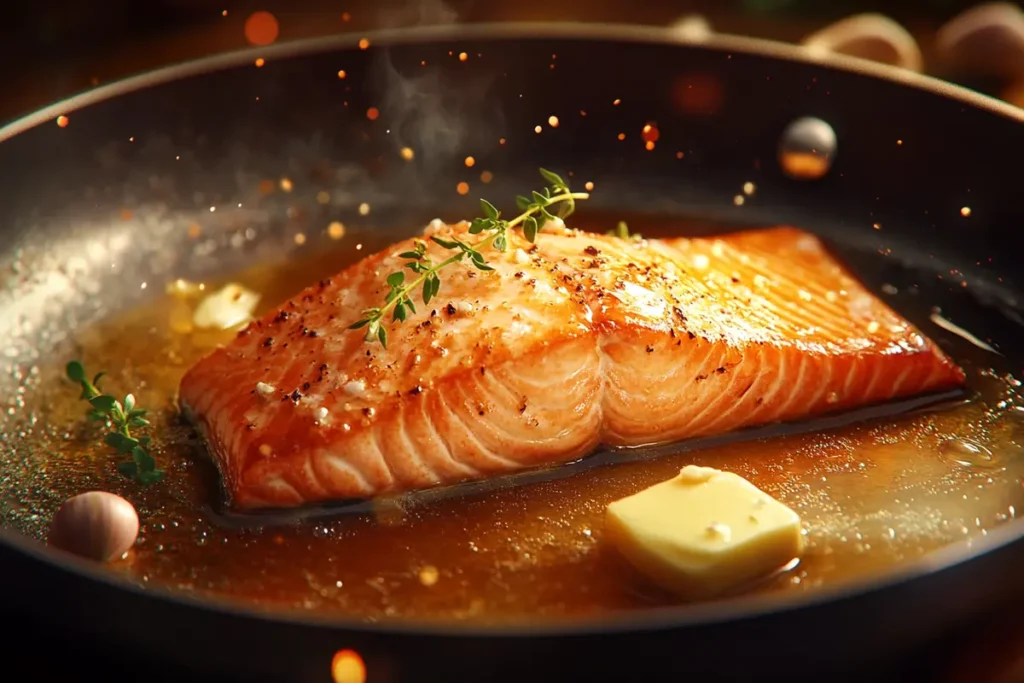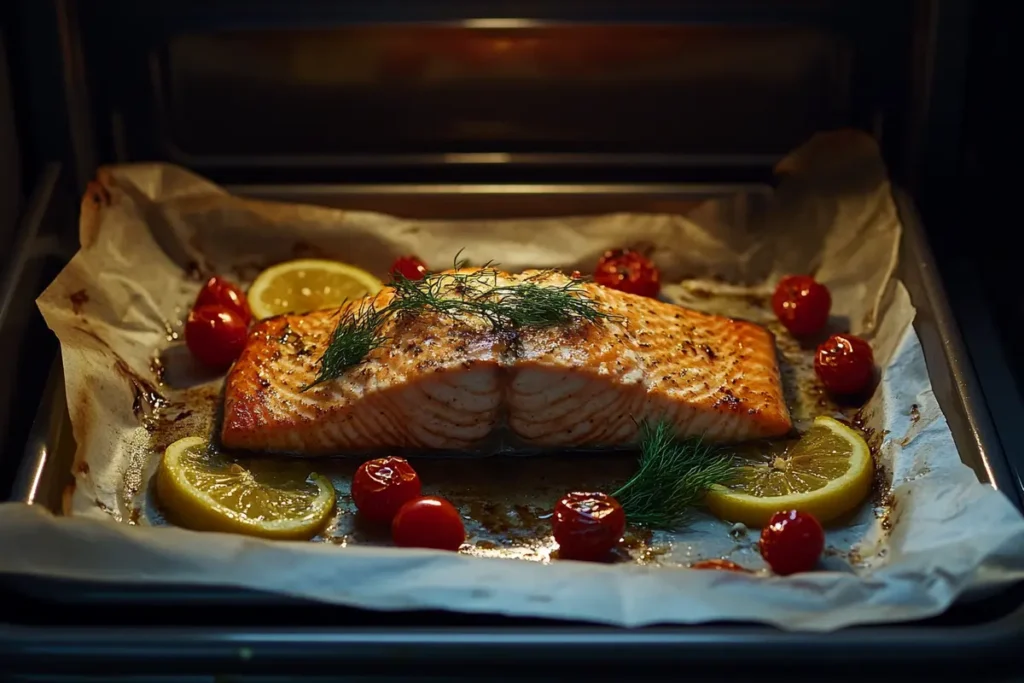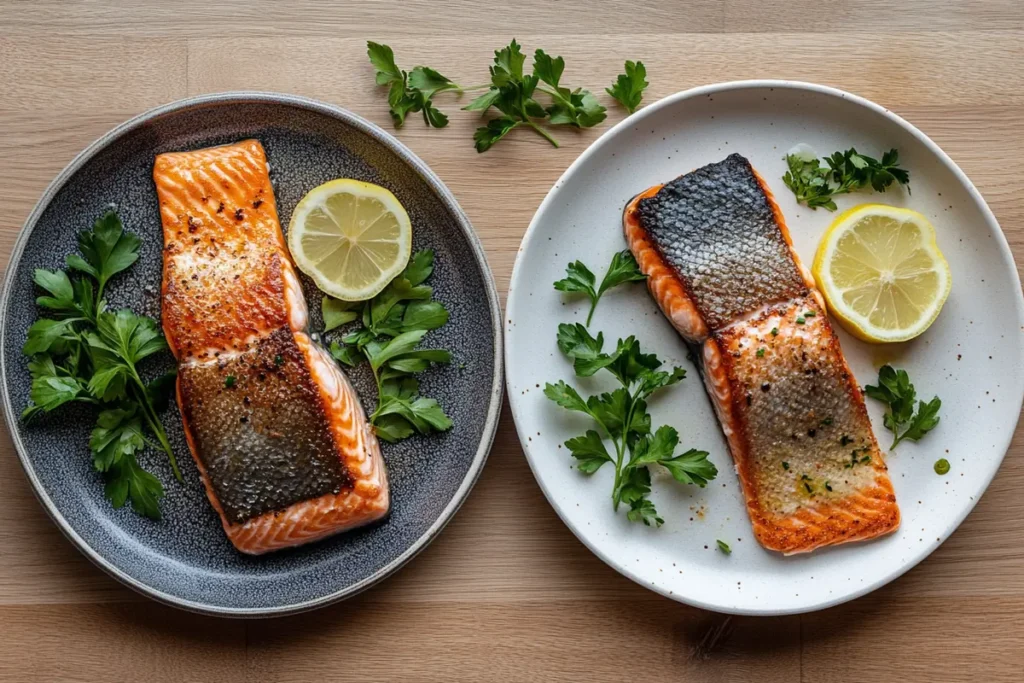When it comes to cooking salmon, one of the healthiest and tastiest proteins, the debate between frying and baking is a hot topic. While both methods bring out unique textures and flavors, the choice often boils down to personal preference, health goals, and culinary expertise. In this guide, we’ll dive deep into the art of frying and baking salmon, exploring techniques, benefits, drawbacks, and comparisons. So, is it better to fry or bake salmon? Let’s find out!
Table of Contents
Understanding Salmon and Its Nutritional Value
Nutritional Profile of Salmon
Salmon is a powerhouse of nutrients, making it a favorite for health-conscious foodies. Packed with high-quality protein, essential vitamins like B12, and minerals like selenium, it supports everything from muscle growth to immune function. One of the standout benefits is its abundance of omega-3 fatty acids, which contribute to brain health and cardiovascular wellness.
But, wait, there’s more! Unlike other proteins, salmon provides a rich source of astaxanthin, a potent antioxidant that helps combat inflammation and oxidative stress. Whether you bake or fry salmon, the nutritional content can vary slightly, making the cooking method an essential consideration. So is it better to fry or bake salmon?
Health Benefits of Omega-3 Fatty Acids
Did you know that omega-3 fatty acids are not naturally produced by the body? This is why salmon is such a star. These healthy fats reduce the risk of heart disease, enhance brain function, and may even alleviate symptoms of depression. Whether you’re frying or baking, ensuring omega-3 retention is key to maximizing these benefits.
Studies show that gentle cooking methods, like baking, preserve omega-3s better than high-heat methods such as frying. That said, frying can still be a great option if done correctly with the right oil. So the question remains: is it better to fry or bake salmon?
Importance of Cooking Methods on Nutrient Retention
While salmon is undeniably nutritious, the method you use to cook it can make or break its health benefits. The question to ask would be: “Is it better to fry or bake salmon?”. In fact, high temperatures during frying can sometimes degrade certain nutrients, including omega-3s. On the other hand, baking is often gentler and preserves nutrients more effectively.
The key lies in balancing flavor and nutrition. Frying often brings out a delightful crispy skin that’s hard to resist, while baking retains tenderness and moisture. Choosing between frying and baking salmon ultimately depends on what you prioritize: a burst of flavor or maximizing health benefits. Let look closer and see: is it better to fry or bake salmon?
Frying Salmon
Techniques for Frying Salmon
Frying salmon is an art that combines heat, timing, and the right techniques. The beauty of frying lies in its ability to create a perfect contrast between crispy, golden skin and tender, juicy flesh. Begin by selecting fresh salmon fillets with the skin intact. Skin-on fillets help retain moisture and create that delightful crunch.
Start by patting the fillet dry with a paper towel to prevent splattering during cooking. Season generously with salt, pepper, and any other desired spices. A well-heated non-stick pan is crucial for avoiding a stuck mess. Add a drizzle of oil avocado or olive oil works wonders for high-heat cooking and place the salmon skin-side down. Let it sear undisturbed for a few minutes before flipping. Voilà, a sizzling masterpiece!

Pan-Frying vs. Deep-Frying
While both pan-frying and deep-frying can elevate your salmon, they deliver entirely different outcomes. Pan-frying, often the go-to method, requires minimal oil and focuses on achieving a golden crust while keeping the fish’s natural flavor intact. This method is healthier and provides better control over texture.
In contrast, deep-frying submerges the salmon in hot oil, producing an ultra-crispy exterior. However, it’s calorie-heavy and may overshadow the fish’s delicate taste. For those who crave crunch but want to stay health-conscious, pan-frying is the middle ground between flavor and health benefits.
Achieving Crispy Skin and Juicy Flesh
To achiveve crispy skin is all about patience and precision. Always place the salmon skin-side down first, as this allows the skin to crisp up beautifully. Using medium-high heat ensures the skin cooks evenly without burning. Pressing lightly with a spatula ensures even contact with the pan.
To retain juicy flesh, avoid overcooking. The ideal internal temperature for perfectly cooked salmon is 125–130°F (51–54°C). Remember, salmon continues to cook slightly even after you remove it from the heat, so err on the side of undercooked for tender results.
Common Mistakes to Avoid When Frying Salmon
Even seasoned cooks sometimes slip up when frying salmon. One common mistake is skipping the preheating step. A cold pan can cause the fish to stick, ruining its presentation and texture. Another misstep is overcrowding the pan, which lowers the temperature and leads to uneven cooking.
Additionally, using the wrong type of oil can spell disaster. Low-smoke-point oils like butter can burn quickly, imparting a bitter flavor. Lastly, flipping the salmon too early disrupts the formation of a proper crust. Practice patience, and let the sizzling work its magic.
Baking Salmon
Techniques for Baking Salmon
Baking salmon is a foolproof method for tender, flavorful fillets with minimal effort. Start by preheating the oven to 375–400°F (190–200°C), a sweet spot for even cooking. Line a baking sheet with parchment paper or aluminum foil to prevent sticking and make cleanup a breeze.
Season the fillets with herbs, spices, and a drizzle of olive oil. For added flavor, try creating a bed of vegetables like asparagus or zucchini for the salmon to rest on. Baking retains the fish’s natural juices while allowing flavors to meld beautifully.

Oven Temperature and Timing
Temperature and timing are key to perfectly baked salmon. Higher temperatures like 400°F (200°C) work well for quick cooking, while lower temperatures around 350°F (175°C) allow for a slower, more even process.
For fillets, bake for 12–15 minutes, depending on thickness. Use a meat thermometer to check doneness, aiming for an internal temperature of 125–130°F (51–54°C). Overcooking dries out the salmon, while undercooking leaves it too raw, so precise timing is crucial.
Using Foil and Parchment Paper
Foil and parchment paper are your best friends when baking salmon. Wrapping the fish in foil creates a steaming effect, locking in moisture and enhancing tenderness. This technique, known as “en papillote,” is perfect for infusing salmon with herbs, lemon slices, and even vegetables.
Parchment paper, on the other hand, allows for a lightly crisped surface while keeping cleanup easy. Both methods reduce the need for excessive oil, keeping the dish lighter and healthier.
Enhancing Flavor with Herbs and Marinades
Salmon is like a blank canvas, ready to absorb any flavors you throw its way. Before baking, marinate the fillet with a mix of olive oil, lemon juice, garlic, and fresh dill. Alternatively, rub it with a blend of smoked paprika, cumin, and a touch of brown sugar for a bolder profile.
Adding fresh herbs like parsley, thyme, or cilantro before baking elevates the flavor further. As the salmon bakes, the herbs infuse the flesh with their aromatic oils, making every bite burst with freshness.
Now the we have seen different cooking methods, is it better to fry or bake salmon?
Comparing Fried and Baked salmon: Healthwise, is it better to fry or bake salmon?
Health Implications of Frying vs. Baking Salmon
When deciding whether to fry or bake salmon, health is often a major consideration. Both methods have unique effects on the nutritional value of this omega-3-rich fish. Frying typically requires oil, which increases the calorie and fat content of the dish. However, when done with healthy oils like avocado or olive oil, frying can still be part of a balanced diet.
Baking, on the other hand, is a lower-fat cooking method that uses indirect heat. This makes it an excellent choice for those seeking to preserve nutrients without adding extra calories. For those managing cholesterol or aiming for weight loss, baking salmon may be the healthier option. Ultimately, both methods can be healthy when paired with fresh ingredients and proper techniques.

Is it better to fry or bake salmon for Calorie and Fat Content?
The calorie and fat content of salmon dishes can vary significantly based on the cooking method. Frying, due to the use of oil, can add up to 50–100 extra calories per serving. Moreover, if you deep-fry salmon, the batter or breading can substantially increase fat levels.
In contrast, baking doesn’t require any added fat unless desired for flavor. For example, a light drizzle of olive oil during baking can enhance taste without heavily impacting calorie count. On average, baked salmon contains fewer calories and less saturated fat than its fried counterpart, making it ideal for a heart-healthy diet.
Is it better to fry or bake salmon for Omega-3 Fatty Acids and Other Nutrients content?
The way you cook salmon plays a significant role in how well it retains its essential nutrients. Frying at high temperatures can cause a slight reduction in the fish’s omega-3 fatty acids, as some of these healthy fats may oxidize during cooking. Additionally, prolonged exposure to high heat can break down heat-sensitive vitamins like B6 and B12.
Baking, however, is gentler on nutrients. The steady, even heat helps salmon retain its omega-3s and vitamins, ensuring that every bite delivers the full range of health benefits. While frying may lead to a minor nutrient loss, quick cooking times can still preserve much of the salmon’s natural goodness.
Is it better to fry or bake salmon for Taste and Texture?
The battle between frying and baking often boils down to taste and texture preferences. Fried salmon boasts a golden, crispy skin and a rich, indulgent flavor that many find irresistible. The caramelization process during frying enhances natural sweetness, giving the dish a more robust taste profile.
Baked salmon, by contrast, has a tender, flaky texture and a milder flavor. It’s perfect for showcasing the fish’s natural taste while allowing the added flavors of herbs and marinades to shine. For those who love variety, alternating between frying and baking ensures you can enjoy the best of both worlds.
FAQs: Is it better to fry or bake salmon?
Is it healthier to bake or fry salmon?
Baking is generally considered the healthier option for cooking salmon. It requires little to no added fat, reducing overall calorie and saturated fat content. The lower cooking temperature used in baking also helps preserve the fish’s omega-3 fatty acids and delicate vitamins. Frying, while flavorful and crispy, typically involves added oil, which can increase calorie intake. That said, using healthy oils and proper techniques can make frying a nutritious choice as well.
Is it better to fry or bake salmon for omega-3 content?
Frying salmon can result in a slight reduction of omega-3 fatty acids, particularly when you fry salmon at very high temperatures or for extended periods. The heat involved in frying salmon can cause some oxidation of these essential healthy fats, which impacts their retention. However, if frying salmon is done with proper care such as using medium heat and cooking the salmon just until the flesh is opaque most of its valuable nutrients, including omega-3 fatty acids, remain intact. Baking salmon, on the other hand, tends to preserve these essential fats more effectively due to the gentler cooking process, making baking salmon a preferred option for those prioritizing nutrient retention while cooking salmon.
How can I make baked salmon more flavorful?
To enhance the flavor of baked salmon, start with a good marinade. Combine olive oil, lemon juice, garlic, and fresh herbs like dill or parsley to create a tangy, aromatic infusion. You can also add a sprinkle of smoked paprika or cumin for a smoky kick. Baking salmon “en papillote” with vegetables and citrus slices not only locks in moisture but also infuses the fish with vibrant flavors. Don’t forget to finish with a dash of sea salt and a drizzle of high-quality olive oil for the ultimate flavor boost.
Making the Best Choice for Cooking Salmon
When choosing between frying or baking salmon, it’s all about balancing health, flavor, and convenience. Is it better to fry or bake salmon? That depends on your priorities. Baking salmon is ideal for preserving the fish’s natural nutrients, offering a tender, moist texture with minimal effort. Frying salmon, on the other hand, delivers a bold, crispy experience that’s perfect for indulgent occasions.
Ultimately, the best choice depends on your preferences and dietary goals. By experimenting with both methods, you can enjoy the full versatility of salmon, one of the most nutritious and delicious proteins available.

